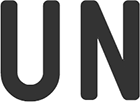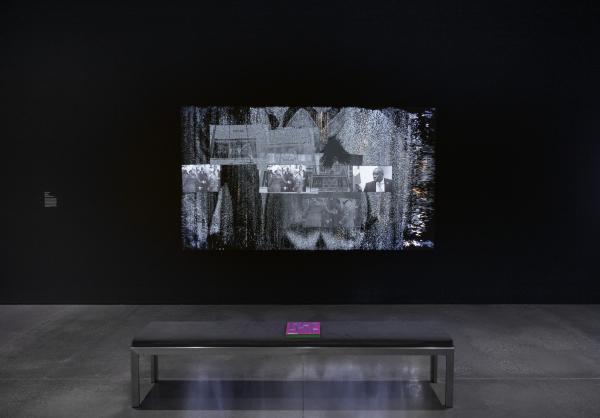As a Renaissance art historian turned LACMA’s social media manager, I spend a lot of time thinking about how artists make sense of the world—and how we can share that sense-making (digitally) in a way that resonates with audiences. Let’s be honest: we’re living through an anxiety-inducing doomscroll come to life. The news cycle is relentless, our feeds are flooded with information, and finding balance can be a struggle, let alone making meaning from any of it. That’s why Wayward (2022), a generative artwork by Daniel Canogar that constantly rebuilds itself from the day’s headlines, feels especially urgent. The work, which is now on view in Digital Witness: Revolutions in Design, Photography, and Film through July 13, doesn’t offer easy answers, but it does what the best art does: it reflects, processes, and transforms. I sat down with Canogar in his studio to talk about Wayward, what it means to witness history mediated by algorithms, and why making art from the noise might be the most human response of all.

Katie Booth: Tell me a little bit about Wayward.
Daniel Canogar: Wayward is a piece that emerged from the daily trauma of watching the news. It has become very turbulent. We're living through crazy times. I am, on the other hand, a news junkie, perhaps even a frustrated journalist. I love journalism, and I've always, from a very young age, consumed a lot of news. Rather than just sit and watch and feel bludgeoned by the daily barrage of news, I decided to respond to that by using images of the news and making an art piece out of it. So the work is tracking the top headlines of the last 24 hours. It then proceeds to find photographs that are attached to that headline on Google, and then creates a composition that's constantly changing because every minute and a half or two, a new headline pops into the artwork. Wayward, in essence, is an artwork that's constantly making artworks. Every couple of minutes, a different artwork is made.
The work is a tribute to artists in the past, particularly from the '60s and '70s, that started cutting pictures out of the newspapers, started collaging them, silk-screening them, and Xeroxing them, using all kinds of technologies to make a commentary of their turbulent times, like our own. The work is an attempt to reference artists like Andy Warhol, like [Robert] Rauschenberg, like Martha Rosler, like Wolf Vostell, and the Fluxus Group. These artists wanted to create art in dialogue with press images. I'm updating that with digital technology.
It's an artwork that's algorithmic. It's generative. It has up to over 600 compositional rules. I couldn't stop thinking of different possibilities, different ways of using the images, collaging them, layering them. There's always a foreground and a background. And in a way, the work in itself has infinite possibilities, because those 600 compositional rules also factor in the news itself, which is always unpredictable, and there's always unexpected things coming down the pipeline. So it's a work that never repeats itself. It's a work that never stops. It's a work that witnesses our times, these very crazy times that we were experiencing, and makes art out of them.
KB: Does this work change your relationship to the news? How does it make you feel after spending time in front of it? Is it therapeutic?
DC: When I say conceiving Wayward as a therapeutic process, I really mean it. There is something about turning the burning news, the breaking news, into art. It allows me to process it in a way that maybe makes it less urgent. And it allows me to, more importantly, put it into an historical context, like an historical arc of a story that we're not really seeing because we're in the thick of it. Wayward’s references to artists from the '60s and '70s is not arbitrary: they, too, were going through very turbulent times, including the war in Vietnam, street demonstrations, and student protests, et cetera. They didn't know how things were going to end. We don't know how things are going to end. So there's something about connecting with those artists of that era that makes me feel like I am somehow drawing this historical arc between our times and past times, and in a way, feeling that we're immersed in the trajectory that we're not quite seeing right now. And that makes me feel a little less anxious about watching the news. And, to be honest, also finding beauty, and we need beauty.
KB: There is a theatrical element to it. Even the way this screen is installed, it reminds me of Ellsworth Kelly putting a canvas on the floor, coming towards us. By placing, in this case, the screen on the floor and leaning it on the wall, it turns it into this very painterly object.
DC: And there is also a reference to painting in the artwork. I'm very interested in painting. I mean, the history of painting, particularly, and how I'm trying to reinvent it through media art, through algorithms.
That conversation with art history, as any conversation that one has with history in general, allows us to give more context about how we interpret the present. And this is why art history hasn't just become a gratuitous reference in my work. It's just literally helping me out navigate the confusion of the times we're living by our heart.
KB: What types of news sources does it pull from?
DC: We wanted something quite broad in terms of international news. However, for the LACMA version, because of the special times of pre-elections, the elections, post-elections, this massive transformation of the political culture of this country, which is, of course, crazy, we tweaked the algorithm to prioritize U.S. news just because I wanted it to be a digital witness of this period.



